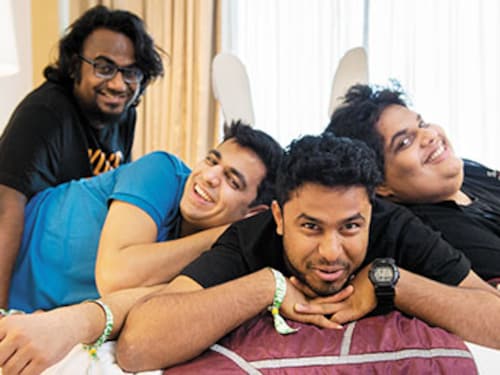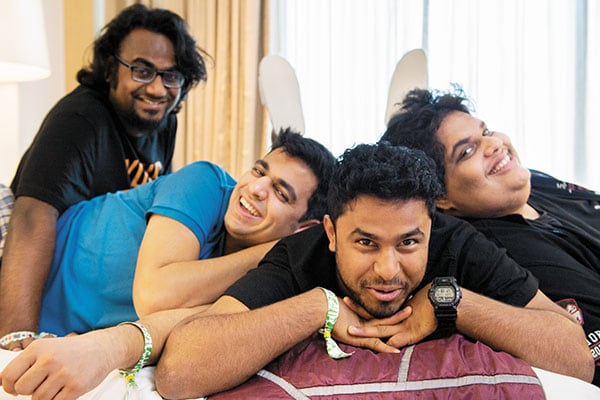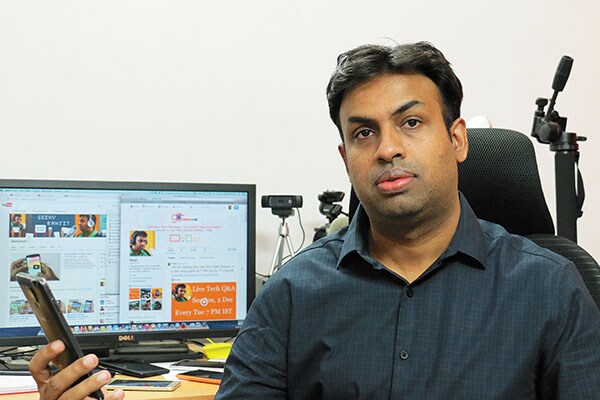Video ga ga: The new tube in town
Move over, television. There are some new kids in town


There are many things one can, in teenspeak, ‘hate on’ Justin Bieber for. But it’s only fair to say that he showed the world the power of online video as a star-maker. A prodigy who had taught himself piano, drums, guitar and trumpet, the then-12-year-old Canadian also had that certain something that makes for stardom. Perhaps it’s what the New York Times in 2010 called “his charisma, high energy and sweet gawkiness”. Even so, he might have gone undiscovered. But his proud mother first posted videos of him singing covers of popular songs on YouTube (YT), the online video channel, where an agent saw them, tracked him down and signed him to a record deal. Bieber assiduously built up a larger YT following, launched a debut album in 2009, and is today, at 20 and still too young to drink alcohol in some parts of the world, a wealthy celebrity: Our colleagues at Forbes ranked him among the 10 most powerful celebrities in 2010, ’11 and ’12, and though his rank slipped into the 30s in what was a rather rocky 2014 (he got arrested twice, among other things) he’s still sitting on earnings of around $80 million for the year.
While Bieber still has the second-most-watched YT video ever (his song ‘Baby’ first place is ‘Gangnam Style’) albeit also the most disliked video ever, he isn’t the platform’s most-followed or most-viewed. His 10.89 million subscribers and 5.43 billion views* have him at only No. 25. Above him, aside from generic channels, like Music and Gaming, and a few pop stars, are other made-in-YT phenomena like Felix Kjellberg aka PewDiePie (34.51 million subscribers, 7.85 billion views), who plays video games and comments on them, comedian Germán Aranis (HolaSoyGerman, 21.22 million, 1.72 billion), comedy duo Ian Hecox and Anthony Padilla (Smosh, 19.76 million, 4.06 billion), vlogger (that’s a portmanteau of video + blogger), Jenna Mourey (JennaMarbles, 14.68 million, 1.68 billion), and Ryan Higa, another comic (nigahiga 13.74 million, 2.06 billion).
Unsurprisingly, some of these acts have parlayed internet fame into thriving enterprises. Smosh now have a number of other YT channels, have released several albums and have a film in development. Mourey has a product line. Michelle Phan started out by doing make-up tutorials she now runs a cosmetics startup that Forbes says does $84 million in annual sales. Bethany Mota, who essentially vlogged her shopping, is now a designer herself. The most Googled fashion designer of 2014, thank you very much. And she’s 19.
Nearer home, the online video scene is a little different, and not just in scale. The top 15 YT channels in India are music majors (No. 1: T-Series, 6.5 million subscribers, 3.25 billion views), television channels that also release their content online, or movie studios. The first true independent comes in at No. 16: The comedy collective, All India Bakchod. Image: Amit Verma
Image: Amit Verma
(From left) Ashish Shakya, Rohan Joshi, Tanmay Bhat, and (front) Abish Mathew, a frequent collaborator. (Gursimran Khamba was not available for this shoot)
Channel: allindiabakchod
Subscribers: 953,616
Views: 58,669,310
Videos: 51
All India Bakchod (AIB) started as a podcast run by two stand-up comics and good friends, Tanmay Bhat and Gursimran Khamba, in 2012. They were later joined by two other comics and friends, Rohan Joshi and Ashish Shakya. They perform as a collective, and have a huge and loyal following.
Bhat, Joshi and Shakya all made their solo debuts within a month or two of each other, around four years ago, at open mic nights run by Vir Das, a stand-up comic himself. Khamba lived in Delhi at that time but, shortly after, he moved to Mumbai too. Bhat says performing at the erstwhile Comedy Club got them a lot of media exposure: “We were in the papers practically every week.” Joshi adds, “We had more interviews than shows at one time!” Which in turn led to the top rung of Indian comics getting regular gigs at corporate events. “Get two corporate shows a month and that sorts you monetarily. Then we all worked for Weirdass [Vir Das’s company], learnt to write sketch…,” says Bhat. Then Khamba and Bhat started their podcast, which they then tried out at live events. They were reluctant YouTubers at first. YT’s team were actively searching for talent to open channels, and OML, an event management company, also worked on them to make videos. Their first few sketches were, they say, terrible. “Then we got one right.”
That was September 2013, when their video called ‘Rape? It’s your Fault Women’ was released. Featuring actor Kalki Koechlin and VJ Juhi Pandey as women taking the ‘blame’ for sexual violence, the video quickly went viral that evening, it was being discussed on prime time news TV. AIB had now acquired fresh cred, not just for bawdy irreverence, which they had already displayed, but for tackling social ills with humour, in the tradition of comedy legends like George Carlin.
The next stepping up of their game came a year later, in August 2014, when their ‘Alia Bhatt: Genius of the Year’ hit the internet. It was aided not a little by very professional production and a canny choice of subject: One of Bollywood’s most famous young actors, her very public goof-up on a talk show and her quest for ‘redemption’. But what made this 10-minute short a break-out moment for Indian comedy, and took it straight to everyone’s social media forwards, was that in a world where public figures seem to stand rather firmly on their dignity, a hugely popular film star was willing to make fun of herself in public. The video has over 8.3 million views as of now. AIB had truly arrived.
In fact, they are the establishment, we point out. They respond with unexpected seriousness. Joshi: “Yes, you get a certain amount of popularity and you become the system.” Khamba: “We did themed shows, others started doing it too. We went on YouTube, so did others. We got lucky with that…” Shakya: “F*** that. Not lucky.” Bhat: “We’ve been around a little longer, so logically, yes.” Joshi: “We’d got more experience, through writing for Weirdass, so we had more exposure that younger people hadn’t. Just to put that in perspective, senior means we’ve been around for four years.” And just like that, as they continued to do through the time we talked, all four break into a stream of jokes and anecdotes, chortling all the time. These guys live their work.
Joshi continues, “We’ve had an entire cycle happening in a few years. The independents, then the MCNs [multi-channel networks, see p117], which are the equivalent of the big movie studios, came in. And already talent is saying, ‘You know what? I’m done with the MCNs!’ It’s all very accelerated.” Khamba interjects: “They’re all playing the valuations game. They’re all hoping to get acquired.” In other words, consolidation is imminent.
“It’s now going the other way,” Bhat sighs. “People think just getting on YouTube means you’re going to make it. They’re just shoving content out. It doesn’t work like that.”
AIB’s YT channel is populated not with their stand-up but with skits and special material created expressly for the medium. Also, as Khamba says, “We can’t put all our sh*t out. We’d get into trouble.”
We discuss how they’re so comfortable with each other, they can practically finish each other’s jokes. Which speaks for their camaraderie, but is also a worry, Bhat says, because they could get predictable. Khamba adds, “When we started the podcast, I didn’t know what [Bhat] would throw at me. Now, I hear him, and I can predict what he’s going to say, and I’m already planning my retort. It becomes tough to come up with new content.”
That’s why they’re on the lookout for new blood. “But where’s the talent?” Bhat asks. “Please, someone come take all our money, but join us.”
(This conversation took place before AIB held their charity event, Knockout, India’s first celebrity roast. The event video, which they later released on YT, clocked millions of views in a matter of days. Its massive popularity was also its undoing: Despite it being an edited version of the show, with some of the riper parts left on the editing floor, it raised the hackles of India’s moral policing brigade. AIB eventually took the video down but, as this issue goes to press, an FIR was filed. The legal implications and fall-out are still unclear.)
Channel: scherezadeshroff
Subscribers: 37,011
Views: 5,696,546
Videos: 149
After 10 years as a model, Scherezade Shroff dabbled in fashion blogging for a bit. Soon, an MCN got in touch to ask her to start a YT channel on the same subject. She tried it out and, after a few months, decided she liked it enough to leave the channel and start on her own, in 2013. She loves the connect she feels with video. “It’s so direct. You can tell if a person is being real or not. The moment I discovered video, I stopped writing, pretty much.”
In some ways she had an easy start, with the MCN she worked for providing support, plus an early mover advantage, and that channel quickly went to number one in its category in India. But it was different when she went solo: “It was tough to leave those 25,000 viewers and start again on my own. But it started getting better.” Upgrades in equipment, editing skills getting better, all helped, she says, plus “YouTube India’s support with events and creating awareness helped grow viewership quicker than if it had just been organic growth”.
While she’s “a full-time YouTuber”—she quit modelling two years ago—what she makes from Google is just a part of her income a bigger chunk comes from ‘brand associations’, where she is paid to demonstrate and showcase products by their manufacturers. She emphasises that her associations are only for products she would use anyway, and she is careful to make those collaborations clear to her viewers, because she needs their trust for her regular reviews.
She gets mails by the hundreds from subscribers telling her about their new channels while India was slower to start, she says, “We’re going to see a lot more YouTubers soon!” Channel: geekyranjit
Channel: geekyranjit
Subscribers: 183,321
Views: 53,509,661
Videos: 1,311
Ranjit Kumar is an old-school geek. He started playing around with computers in the late ’80s: “I used to experiment, take things apart, get into trouble.” He taught himself programming, networking, some assembly language, so he appreciates, in a way few youngsters today can, the rapid advances computing technology has made. “We live in a fairyland these days!”
After some years working for others, he quit in ’99 to work on his own. All along, he had been the go-to guy for friends who needed advice on gadgets. It seemed natural to him to make a web site and put up stuff about his experiences using the gadgets he owned. While it was “a casual kind of thing,” he was, nevertheless, incensed to find his posts being plagiarised, but there was little he could do: “How many take-down requests can you file?” Around then, he realised that his own web research was shifting towards online video, “and it clicked in my head. You can explain the kind of things I do far easier with video. So in 2011, I started geekyranjit.” A year later, he had 1,600 subscribers. And it was tough going: A five- to six-minute video takes that many hours to make. What kept him going was the sense of community on YT, the regular feedback and encouragement. And he consistently listened, and modified his content accordingly—less hardcore stuff about motherboards and similar things, to more consumer tech, smartphones—which is why he thinks viewership picked up. It’s demanding: He spends from 12 to 16 hours a day on channel-related work, and has cut back on his other job, consulting. It helps to work from home, since he gets some family time, but there’s little time for loafing. His YouTube Partner status makes him money, but his expenses are high, since he has to keep buying the gadgets he reviews. He was running at a loss the first couple of years, but now makes a respectable income from the channel, though not as much as he expected, and, for sure, less than he was making from his consulting work. “The kind of job satisfaction I get,” he explains, “you can’t evaluate in monetary terms.” Channel: CookingShooking
Channel: CookingShooking
Subscribers: 66,203
Views: 9,535,144
Videos: 184
Yaman Agarwal loved watching his mother cook, and he got interested enough to start doing research on his own at age 12 online, naturally. And he found that his searches were inevitably throwing up YT videos. A whole new world opened up for him. By the time he was 14, two years ago, he decided that if others could do it, there was nothing stopping him from sharing his passion with the world too, and he started CookingShooking.
When he decides to vlog a new dish, he first goes out to eat it in a few different restaurants in his hometown, Hyderabad. Then he researches it online and experiments in the kitchen to get it right. “You could say I am self-taught,” he says. The event that played a big part in his rise was his decision to make something original for Independence Day. He eventually came up with a tricolour cake with an eggless recipe that was a big hit. His promotion of it on food-related online groups brought in more viewers, and from then on his subscriber count began to rise. This also helped him to decide his focus, his speciality: Eggless baking without an oven.
While he does monetise his content (he says he stumbled on the option by accident), he isn’t too concerned about how much money comes in. “It varies depending on many factors,” he says, and he doesn’t spend much time on things like optimisation. “I’m just pursuing my passion. Whatever I get, I save it and invest it in my videos. You can see the quality difference even over six months.”
When we ask how his contemporaries react to his fame, he gets a little bashful, to the extent of declining to name his school apparently juniors there can be rather cruel about a boy defying stereotypes. His close friends and his family, though, are proud of him and give him loads of support. His future plans are to go to a culinary academy and eventually become a chef. “The best professional chefs are men, after all.”
Channel: NishaMadhulika
Subscribers: 219,765
Views: 66,878,987
Videos: 967
Nisha Madhulika doesn’t quite fit the stereotype of the brash young new economy creator. She is in her mid-50s, cheerfully denies understanding technology and is uncomfortable with English. She used to work with her husband, in a family-owned software business in Delhi, which she enjoyed, she says. But when they bought a home in Noida, she found the commute to Delhi too tiring. She chafed at the idea of doing only housework, but hadn’t a clue about what else she wanted to do, except that it must be something that was both useful to others and that she liked. In the mid-2000s, her husband began reading blogs she would browse occasionally too, and thought this was something she would like to do, except, what would she write about? Which is when she discovered recipe blogs. She told her husband, “Other topics don’t interest me, but I can write recipes.” He told her that that was what she should write then, and promptly bought her a digital camera. This was in 2007.
She would cook, take photos of the food, type out recipes and post. Her blog quickly gained readers, who encouraged her to post more. She was delighted: “I always liked cooking, but never thought it could be useful for others!” Along the way, her son made her a proper web site, and by 2011, she had around 600 recipes up. Her devoted following—in India and the desi diaspora—had been urging her to post videos, to make it even easier to follow her recipes. Her kitchen wasn’t ideal for a shooting set, so she hadn’t taken it seriously. Her husband, ever supportive, set up a studio for her in an upstairs room (nothing fancy, a hob, cameras, lights), and she began her career as a video star.
A few months in, with a 100 recipes online, Google got in touch and invited her to be a YouTube Partner and monetise her videos. She’s quite pleased with her income—“I make a lot, and get fame, both more than I had ever hoped for!”—but says her Google terms do not permit her to disclose exactly how much she makes. And she’s refused all offers from MCNs thus far: “I like independence more.” She does traditional recipes, but in her own style, as well as researching and inventing her own. It’s a full time job, 11 am to 5.30 pm, six days a week, much the same as when she worked with her husband. Two days are for shooting, the other four for developing and writing recipes, and replying to fans.
She’s having the time of her life, she says. “I had dreamt, from childhood, that whatever I would do, I would be the best: If medicine, I’d be the best doctor, if teaching, the best lecturer people would know my name. Those things didn’t happen, for many reasons,” she says, laughing, “but with what I’m doing now, I’m fulfilling my ambitions!” Channel: sonalsagaraya
Channel: sonalsagaraya
Subscribers: 13,689
Views: 1,488,526
Videos: 161
Sonal Sagaraya stumbled into YT searching for a solution to a problem she had in the animation course she was taking. She found her answers, but also got interested in the sense of community she found there. She gravitated towards the beauty vlogs, and it struck her that she could do this too: She had always been into it, she said, so she wouldn’t have to actually work on content. She happened at that time—about four years ago—to meet an old school friend who had just bought a DSLR camera, and she asked him to film her for her videos. (They eventually became business partners.)
At first, they uploaded sporadically, but as time went by, they saw their videos getting a lot of emails and comments, asking for more. So, around two years ago, they began to take it more seriously. They also got a lot of help from YT’s team, technically as well as on things like optimisation. They aim now for two or three videos a week, but at busy times (they get invited to a lot of events) they ensure that at least one goes up a week. They shoot mainly in a vacant flat that belongs to one of her relatives, where they have made miniature sets in various parts of the house for the different types of shoots they do, and occasionally film outdoors.
Aside from the regular demos and reviews, the channel’s popularity has brought her brand deals that bring in more income. Even so, from the days when “we made peanuts,” they still just about break even. Part of the problem, she says, is that a lot of their views come from mobiles and tablets, and those platforms are not totally monetised. “Those are a waste,” she says, and then laughs as she corrects herself: There are eyeballs and views to be gained, but no money does make a difference.
Has she been approached by the MCNs? “Oh god! There are billions of them! When I started, there was nobody. Now, every day there’s a new one.” She says she had a bad experience with one MCN (which she refused to name) and quit them within two months. She intends to stay away from the entire breed. Besides, the support she gets from YT is “awesome! Any issues I’ve had, they’ve resolved really quickly.” They like the experience so much, they’re going multichannel themselves: A science channel first (QuickBrainFuel, where roles are reversed: Sagaraya shoots, her partner Rushabh Shah presents), then a talk show and other channels.  Channel: shraddharockin
Channel: shraddharockin
Subscribers: 165,553
Views: 12,733,546
Videos: 31
If there’s anything close to Justin Bieber’s story in India, it’s Shraddha Sharma’s. At 15, this girl in quiet Dehradun already had a wise head on her shoulders. She had learnt Hindustani classical singing for a few years at her mother’s insistence (her mother sang herself, and taught singing), but had decided that that form was not for her. She had, though, decided she wanted to make it as a singer, but had also realised that the TV talent show route was not for her. She had seen this “cool thing called YouTube with people singing, playing guitars and all, and decided to do it. It’s a direct connect [unlike the TV shows], no judges, no lines. If you have that zing factor, people really pick it up.” So she put her iPhone in front of her, turned on the camera, and strummed her guitar while she sang covers, and uploaded the videos to YT. She got a few hundred views, some favourable comments, so she did another, and then another. And then her fifth “went viral. From a few thousand views, it became one lakh. One lakh turned to five lakh…” As simple as that.
She was approached by an MCN, who signed her for a two-year contract. They handled her channel, doing the monetisation for her, leaving her free to do her thing. It didn’t end well, though: The MCN sued her for breach of contract. “I got sued for something that didn’t happen: The contract was about to get over, and I didn’t renew. These things happen,” she says, as matter-of-factly as a show biz veteran. She won the case, and is now signed up with Qyuki, and things are going well again, so she’s concentrating on “getting better, improving my singing”. She’s learning Western music, while continuing her classical riyaaz, and studying for a college degree via correspondence, though, she confesses, she hates studying. And she’s moved to Mumbai, and is living alone in the big city to pursue the music career she wanted.
“Of course it’s difficult,” she says mournfully. “I’m far from my family, I have no friends here, there are food crises, traffic, two-faced people… There are times when I just want to take the next flight and go back to Dehradun! But then I sit back, I think: There will be problems. You have to take them, you can’t back out.”
And how is the career going? She’s done mainly cover songs, so she couldn’t monetise most of her videos. But now, her MCN can buy rights for her, so that can change. And of course she can monetise her originals. And then Universal Music signed her up and there’s an album out, Raastey, which has “done pretty well on iTunes”.
She’s doing live shows. She’s sung for an ad. She’s judging an all-India singing competition (it’s not a TV show, so no irony points deducted).
What’s next? “There’s so much happening. I’m just taking it as it comes. I’m only 19!”
I tell her that one could forget that fact, with all the maturity she shows. She giggles acknowledgement.
A decade ago, being a successful musician would have almost certainly required getting a contract with a major record label. They’d pay you, record your music and market it for you. Forty-six-year-old Ravi Iyer has never had such a deal. He earned a comfortable income performing in shows and offering guitar lessons, but the big money wasn’t really there. So, one day, he got himself a YT channel and now does most of his marketing himself. “You don’t need to go down that [traditional] path anymore,” he says.
Across India, artistes across genres—comedians, cooks, musicians—are going online, tapping into large audiences via YT (and to a lesser extent Facebook).
Assisting them are multi-channel networks, or MCNs, that help them produce, showcase and market themselves in exchange for a slice of the ad revenue.
“It’s all about first creating the content and then building audiences and then monetising it,” says Samir Bangara, co-founder (with AR Rahman and Shekhar Kapur) and managing director at Qyuki Digital Media.
MCNs at base level, solve practical problems, like providing professional production. Mrinalinee Mukherjee, a 33-year-old make-up artist, faced that dilemma. She couldn’t shoot pro-quality video with proper lighting at home. She’s now signed with Culture Machine, where she gets professional production assistance.
A smooth look is just part of the battle. MCNs also handle optimising content for high rankings on search engines—a key skill few artistes can, or want to, master—plus digital rights management, subscription, ad sales and sponsorships.
Rajeshree Naik, co-founder at Ping Digital Broadcast, says that YT shares 55 percent of ad sales with the MCN, which then deducts its costs and passes the rest on to the artiste.
There is a dark side: Some creators complain, off the record, about exploitative, unethical business practises of some MCNs.
But, for now, most artistes seem to be at peace with what the business folk bring to the table: YT is a great way to get their brand known, and MCNs know the platform well. Iyer, the musician, says that he has noticed an uptick in the number of hits on his personal website. Inquiries for his guitar lessons have increased. Mukherjee, who pays Rs 25,000 every two months to produce a set of eight videos for her channel, also hopes to make enough to give up her full-time job in a few years.
For the MCNs, it’s a race to create the fastest boutique content on the web. The rewards for the largest aggregators of YT content could potentially be huge. Globally action has been heating up. In April, Disney paid $1 billion to acquire Maker Studios, a US MCN. And then in September, AT&T and the Chernin Group bought a controlling stake in Full Screen. There’s every indication that India could also see a deal, albeit smaller, soon.
First Published: Mar 02, 2015, 06:39
Subscribe Now